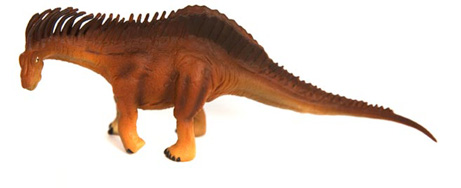Amargasaurus – A Diplodocid that may have been a bit of a Show Off
We have recently been looking at some drawings and designs of dragons and other mythical creatures. Many dinosaurs looked bizarre, for example Amargasaurus, and the comment was made about how fanciful these animals looked with their wings, spines, spikes and frills. The designers had really gone to town letting their imaginations run riot to produce prototypes for a model series.
However, sometimes the truth can be stranger than fiction and a number of prehistoric animals including dinosaurs are believed to have had bizarre ornamentation, spines, frills and crests.
Scientists are still unsure as to the exact purpose of many of these odd appendages, but the fossil record is clearly as capable of revealing any number of bizarre and odd looking animals, a match for the imagination of the sculptors and artists behind many of the dragon models. Unless we have interpreted the fossil evidence incorrectly, these strange features evolved as they gave the animals an advantage in some way.
Amargasaurus
An example of a dinosaur with a bizarre appearance is Amargasaurus (Amargasaurus cazaui), a diplodocid dinosaur related to the better known (and larger) Diplodocus. This sauropod had a disproportionately short neck when compared to other members of this group of dinosaurs but its most striking feature were the rows of spines and spikes that ran along the body from behind the neck to the end of the tail, although spines on the tail is conjecture as the only specimen of this animal discovered to date lacked a tail. Some of our Amargasaurus dinosaur models show lots of amazing detail.
The Bizarre Looking Amargasaurus

Picture credit: Everything Dinosaur
The spines are extensions of the vertebrae, what they were used for is unknown, although several theories have been put forward. The spines may have supported a sail-like structure which may have been used for communication amongst herd members or for temperature regulation. A sail may have helped this animal warm up quickly in the morning and, by facing towards the noon sun, exposing only a minimum part of their body’s surface area, they may have been able to regulate their temperature during the hottest part of the day.
A large sail-like structure on the neck would have inhibited movement of the neck, not a good idea if you are a browsing herbivore. It has been suggested that any sail on the neck did not cover the full expanse of the spines, but in reality the tops of the spines were tipped with horn and were actually defensive spikes to protect a vulnerable part of this animal. An examination of the skull and teeth of Amargasaurus in conjunction with an examination of the length of the neck vertebrae permits us to speculate that this animal browsed on low-lying vegetation. With its head craned towards the ground to eat, it would make sense to have spikes on the neck to prevent a predator grabbing the neck in a surprise attack.
Amargasaurus – A Diplodocid from South America
Picture credit: Everything Dinosaur
To view the range of sauropod models available from Everything Dinosaur including Amargasaurus figures: Dinosaur and Prehistoric Animal Models.
The Carnegie model from the dinosaur collectibles series measures an impressive 22 cm long and this particular hand-painted model was awarded the seal of excellence for creative play by the U.S. based Creative Child Magazine.







Leave A Comment